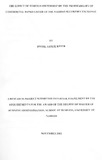| dc.contributor.author | Bwire, Leslie K | |
| dc.date.accessioned | 2013-02-12T14:46:59Z | |
| dc.date.available | 2013-02-12T14:46:59Z | |
| dc.date.issued | 2012 | |
| dc.identifier.uri | http://erepository.uonbi.ac.ke:8080/xmlui/handle/123456789/9044 | |
| dc.description.abstract | Studies all over the world have over the years indicated that foreign banks outperform domestic banks. Several other studied have tackled the question of why this is so and a number of theories have been developed to explain the same. The debate on what are the determinants of bank profitability is however still alive. The banking industry in Kenya has grown over the years since the Central Bank of Kenya put up measures to regulate the banks in order to streamline the activities and more so to prevent the collapse of the banking industry as had been before.
This study analyzed profitability of foreign and domestic banks listed on the NSE. The study sought to: determine whether there are any differences between the profitability of foreign and local banks listed at the NSE; examine the determinants of profitability of foreign and local banks listed at the NSE.
This was a correlational study. The population was listed banks at the NSE and therefore the sample was restricted to the nine commercial banks listed. Three of them were foreign banks while the rest were domestic banks. Secondary data was collected from the 2011 Banking Survey handbook. The CAMEL model was adopted to test the determinants of bank profitability. Data was analyzed using descriptive analysis, One Way ANOVA, correlation analysis, and regression analysis.
The SPSS aided in the analysis. The results were presented in tables. The study found that there were no statistically significant differences between the performance of foreign and domestic listed banks. The regression result also showed that foreign ownership did not affect bank profitability. The study also revealed that none of the variables had a significant influence on ROA or ROE (p>0.05).
The study concludes that listed foreign banks in Kenya do not outperform the domestic listed banks. The study also found out that the CAMEL model is not a good predictor of the determinants of profitability of listed commercial banks in Kenya. The study recommends that there is need for the Central Bank of Kenya to rethink its use of the CAMEL model to gauge performance of banks. The study also recommends that commercial banks should reduce the capital adequacy ratio as it was way beyond the 8% recommended by the CBK. | en_US |
| dc.language.iso | en_US | en_US |
| dc.publisher | University of Nairobi, Kenya | en_US |
| dc.title | The Effect of Foreign Ownership on the Profitability of Commercial Banks Listed at the Nairobi Securities Exchange | en_US |
| dc.title.alternative | Thesis (MBA) | en_US |
| dc.type | Thesis | en_US |

